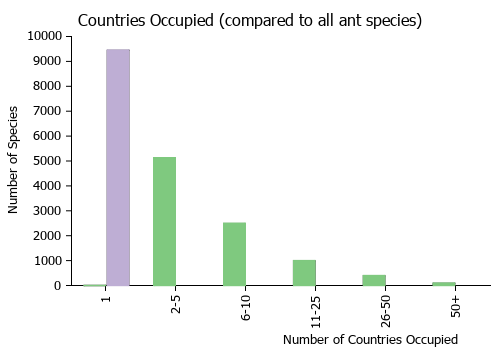Pheidole goeldii
| Pheidole goeldii | |
|---|---|

| |
| Scientific classification | |
| Kingdom: | Animalia |
| Phylum: | Arthropoda |
| Class: | Insecta |
| Order: | Hymenoptera |
| Family: | Formicidae |
| Subfamily: | Myrmicinae |
| Tribe: | Attini |
| Genus: | Pheidole |
| Species: | P. goeldii |
| Binomial name | |
| Pheidole goeldii Forel, 1895 | |
This species is only known from type specimens. Nothing is known about its biology.
Identification
See the description in the nomenclature section.
Keys including this Species
Distribution
Only known from the type locality.
Latitudinal Distribution Pattern
Latitudinal Range: -21.666667° to -21.666667°.
| North Temperate |
North Subtropical |
Tropical | South Subtropical |
South Temperate |
- Source: AntMaps
Distribution based on Regional Taxon Lists
Neotropical Region: Brazil (type locality).
Distribution based on AntMaps
Distribution based on AntWeb specimens
Check data from AntWeb
Countries Occupied
| Number of countries occupied by this species based on AntWiki Regional Taxon Lists. In general, fewer countries occupied indicates a narrower range, while more countries indicates a more widespread species. |

|
Estimated Abundance
| Relative abundance based on number of AntMaps records per species (this species within the purple bar). Fewer records (to the left) indicates a less abundant/encountered species while more records (to the right) indicates more abundant/encountered species. |

|
Biology
Castes
Nomenclature
The following information is derived from Barry Bolton's Online Catalogue of the Ants of the World.
- goeldii. Pheidole goeldii Forel, 1895j: 178 (s.w.) BRAZIL. See also: Wilson, 2003: 429.
Unless otherwise noted the text for the remainder of this section is reported from the publication that includes the original description.
Description
From Wilson (2003): A member of the flavens group, somewhat similar to Pheidole striaticeps of Mexico and Central America, distinguished as follows.
Major: yellow; Head Width equal to Head Length; occipital cleft deep, with subangulate midline cleft; mesonotal convexity apparent in dorsal-oblique view; postpetiole from above diamond-shaped, with right-angular margins; edges of humeri rugoreticulate; propodeal spines half as long as and perpendicular to basal face of propodeum preceding them; edges of humeri rugoreticulate.
Minor: humeri toothed; propodeal spines more than a third as long as and perpendicular to the basal face of the propodeum facing them; occiput narrowed behind; occiput with prominent midline cleft; head, mesosoma, and waist foveolate and opaque.
MEASUREMENTS (mm) Syntype major: HW 1.00, HL 1.00, SL 0.48, EL 0.12, PW 0.48. Syntype minor: HW 0.50, HL 0.54, SL 0.44, EL 0.08, PW 0.30.
COLOR Major and minor: concolorous yellow.
Figure. Upper: syntype, major. Lower: syntype, minor. Scale bars = 1 mm.
Type Material
BRAZIL: Colônia Alpina, Terasópolis, Rio de Janeiro, col. Emilio A. Goeldi. Musee d'Histoire Naturelle Genève and Museum of Comparative Zoology - as reported in Wilson (2003)
Etymology
Named in honor of the collector Emilio A. Goeldi. (Wilson 2003)
References
- Forel, A. 1895c. Die Ameisen- und Termitengäste von Brasilien. Anhang. Beschreibung einiger neuer brasilianischer Ameisenarten. Verh. K-K. Zool.-Bot. Ges. Wien 45: 178-179 (page 178, soldier, worker described)
- Wilson, E. O. 2003. Pheidole in the New World: A dominant, hyperdiverse ant genus. Harvard University Press, Cambridge, MA. (page 429, fig. major, minor described)
References based on Global Ant Biodiversity Informatics
- Kempf, W.W. 1972. Catalago abreviado das formigas da regiao Neotropical (Hym. Formicidae) Studia Entomologica 15(1-4).



